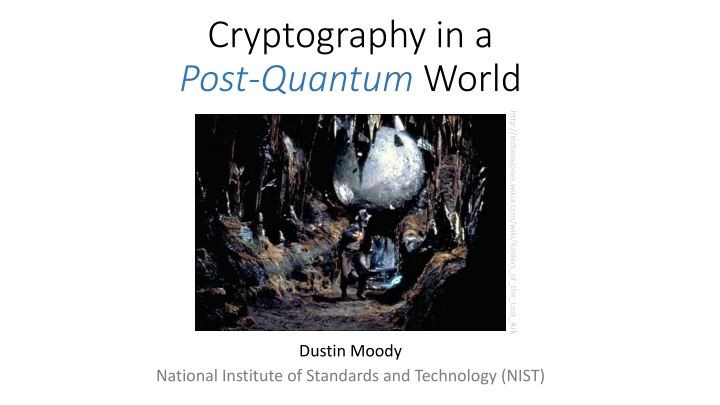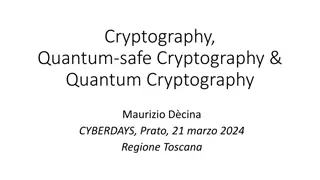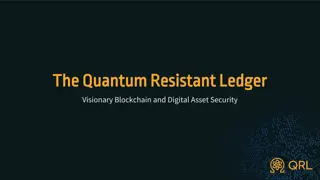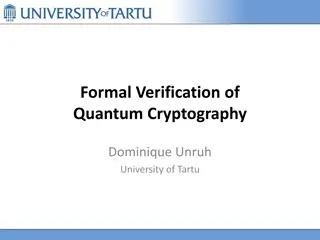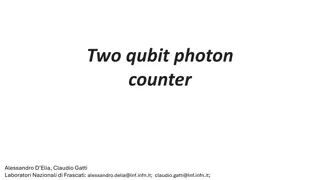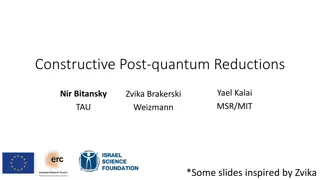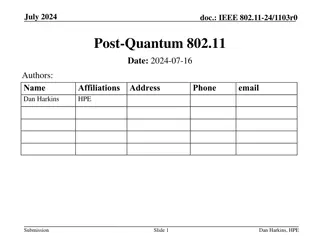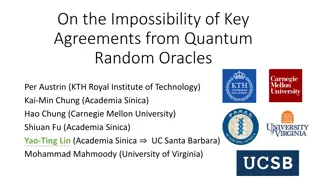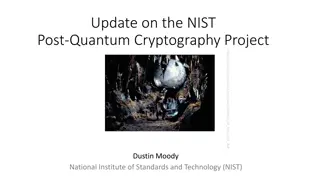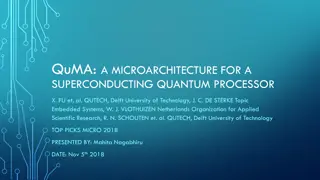Cryptography in a Post-Quantum World
This content delves into the evolving landscape of cryptography in the face of quantum computing advancements, exploring the intricacies of symmetric-key and public-key encryption algorithms, the implications of classical versus quantum computers, challenges of quantum computing, threshold theorems, and progress in quantum algorithms.
Download Presentation

Please find below an Image/Link to download the presentation.
The content on the website is provided AS IS for your information and personal use only. It may not be sold, licensed, or shared on other websites without obtaining consent from the author.If you encounter any issues during the download, it is possible that the publisher has removed the file from their server.
You are allowed to download the files provided on this website for personal or commercial use, subject to the condition that they are used lawfully. All files are the property of their respective owners.
The content on the website is provided AS IS for your information and personal use only. It may not be sold, licensed, or shared on other websites without obtaining consent from the author.
E N D
Presentation Transcript
Cryptography in a Post-Quantum World http://indianajones.wikia.com/wiki/Raiders_of_the_Lost_Ark Dustin Moody National Institute of Standards and Technology (NIST)
Cryptography Alice and Bob want to communicate Beware of Eve Symmetric-key crypto Alice and Bob have a shared key Example: AES (encryption) Public-key crypto Alice has never met Bob, but wants to send him a message Example: RSA (encryption and signatures)
Classical vs Quantum Computers The security of crypto relies on intractability of certain problems to modern computers Example: RSA and factoring Quantum computers Exploit quantum mechanics to process information Use quantum bits = qubits instead of 0 s and 1 s Superposition ability of quantum system to be in multiples states at the same time Potential to vastly increase computational power beyond classical computing limit
Quantum Computers Difficulties When a measurement is made on quantum system, superposition collapses Quantum states are very fragile and must be extremely well isolated Intersection of many developing fields: superconductors, nanotechnology, quantum electronics, etc 1998 2 qubits 2000 4, 5, and then 7 qubits 2006 12 qubits 2011 14 qubits Measuring qubits is not best metric
Threshold Theorem If error per quantum computation can be brought below (roughly) 0.5%, arbitrarily long quantum computations can be performed by correcting errors as you go Threshold Theorems Experimental Error Rates 0.5% (2015) 0.0001% (1997) 5% (1995) Theorists improve error correction schemes to tolerate higher error rates Experimentalists achieve lower error rates
Quantum Computing Progress A lot of progress, but still a long way to go [Image credit: M. Devoret and R. Schoelkopf]
Quantum Algorithms 1994, Peter Shor created a quantum algorithm that would give an exponential speed-up over classical computers Factoring large integers Finding discrete logarithms Grover s algorithm polynomial speed-up in unstructured search, from O(N) to O( ?) Simulating the dynamics of molecules, superconductors, photosynthesis, among many, many others see http://math.nist.gov/quantum/zoo http://math.nist.gov/quantum/zoo
The Sky is Falling? If a large-scale quantum computer could be built then . Public key crypto: RSA ECDSA (and Elliptic Curve Cryptography) DSA (and Finite Field Cryptography) Diffie-Hellman key exchange Symmetric key crypto: AES Triple DES Hash functions: SHA-2 and SHA-3
The Sky is Falling? If a large-scale quantum computer could be built then . Public key crypto: RSA ECDSA (and Elliptic Curve Cryptography) DSA (and Finite Field Cryptography) Diffie-Hellman key exchange Symmetric key crypto: AES Triple DES Hash functions: SHA-2 and SHA-3
The Sky is Falling? If a large-scale quantum computer could be built then . Public key crypto: RSA ECDSA (and Elliptic Curve Cryptography) DSA (and Finite Field Cryptography) Diffie-Hellman key exchange Symmetric key crypto: AES Triple DES Need longer keys Need longer keys Hash functions: SHA-2 and SHA-3 Use longer output
When will a Quantum Computer be Built? Quantum computers are 20 years in the future and always will be
When will a Quantum Computer be Built? 50% chance of breaking RSA-2048 by 2031 (Michele Mosca, 2015) Resources needed to break RSA-2048 (Matteo Mariantoni, 2014) 15 years $1 billion USD Small nuclear power plant Quantum computers are 20 years in the future and always will be
How soon do we need to worry? How long does encryption need to be secure (x years) How long to re-tool existing infrastructure with quantum safe solution (y years) How long until large-scale quantum computer is built (z years) Theorem (Mosca): If x + y > z, then worry What do we do here?? y x z secret keys revealed time
Post-Quantum Cryptography (PQC) Cryptosystems which run on classical computers, and are considered to be resistant to quantum attacks PQC needs time to be ready for applications Efficiency Confidence cryptanalysis Standardization Usability and interoperability (IKE, TLS, etc use public key crypto)
Possible Replacements Lattice-based Code-based Multivariate Others Hash-based signatures Isogeny-based signatures Etc . All have their pros and cons
Practical Questions Which are most important in practice? Public and private key sizes Key pair generation time Ciphertext size Encryption/Decryption speed Signature size Signature generation/verification time Really, a lot more questions than answers
Encryption Schemes Algorithm KeyGen Time (RSA sign=1) 10 Decrypt Time (RSA sign=1) 0.1 Encrypt Time (RSA sign=1) 0.1 Public Key Size (bits) Private Key Size (bits) Ciphertext Size (bits) Time* Scaling Key* Scaling k2 NTRUEncrypt ~3000 ~4000 ~3000 k k2 k2 McEliece 5 1 0.02 651264 1098256 1660 k2 Quasi-Cyclic MDPC 5 1 0.02 4801 9602 9602 k k6 k3 RSA 50 1 0.02 1024 1024 1024 k4 k3 DH 0.5 0.5 0.5 1024 480 1024 k2 ECC 0.1 0.1 0.1 320 480 320 k Disclaimer these are rough estimates for comparison purposes only, not benchmarks. Numbers are for 80 bits of security. * Time and key scaling ignore log k factors
Observations For most of the potential PQC replacements, the times needed for encryption, decryption, signing, verification are acceptable Some key sizes are significantly increased For most protocols, if the public keys do not need to be exchanged, it may not be a problem Some ciphertext and signature sizes are not quite plausible Key pair generation time for the encryption schemes is not bad at all No easy drop-in replacements Would be nice to have more benchmarks
Gathering Steam PQCrypto Workshop series ETSI workshops European PQCrypto project, Japan s SAFECRYPTO project IETF hash-based signatures April 2015: NIST workshop on PQC Fall 2015: NSA announced it would be transitioning in the not too distant future https://www.iad.gov/iad/programs/iad-initiatives/cnsa-suite.cfm Feb 2016: NIST report on PQC- http://csrc.nist.gov/publications/drafts/nistir-8105/nistir_8105_draft.pdf Dec 2016: NIST Call for PQC Submissions
NISTs Standardization Plan Nov. 30, 2017 Submission deadline April 2018 Workshop Submitters presentations 3-5 years Analysis phase - NIST reports on findings and more workshops/conferences 2 years later Draft standards available for public comments NIST is calling for quantum-resistant crypto algorithms for new public-key crypto standards Digital signatures Encryption/key-establishment NIST will release reports on progress throughout We do not expect to pick a winner Ideally, several algorithms will emerge as good choices We may pick one (or more) for standardization NIST will post complete and proper submissions
So What? Post-Quantum Cryptography should be on your radar Be prepared to transition to new (public-key) algorithms in 10 years The transition will not be painless Focus on crypto-agility See www.nist.gov/pqcrypto Sign up for the pqc-forum for announcements and discussion
